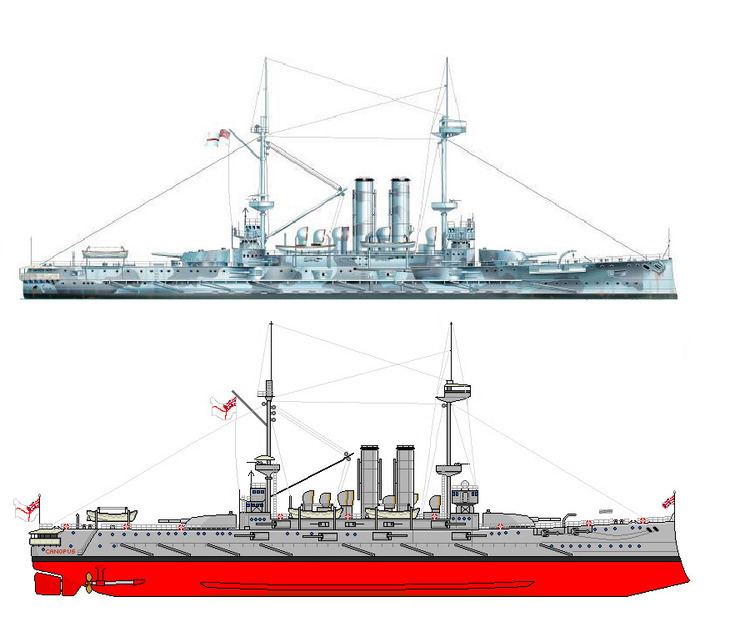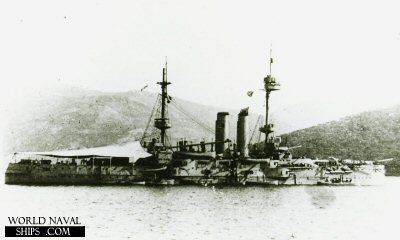Name HMS Canopus Ordered 1896 Programme Laid down 4 January 1897 Construction started 4 January 1897 Length 131 m | Cost £921,316 Completed 5 December 1899 Launched 13 October 1897 Draft 7.9 m | |
Hms canopus 1897
HMS Canopus was a pre-dreadnought battleship of the British Royal Navy and the lead ship of the Canopus class. At the beginning of the First World War she was involved in the search for the German East Asia Squadron of Admiral Graf Spee. Too slow to follow Admiral Sir Christopher Cradock's cruisers, she missed the Battle of Coronel, but fired the first shots of the Battle of the Falklands. Transferred to the Mediterranean she took part in the Naval operations in the Dardanelles Campaign.
Contents
- Hms canopus 1897
- Technical description
- Pre World War I
- World War I
- The search for Admiral von Spees squadron
- Dardanelles campaign
- Later operations
- Decommissioning and subsidiary duties
- Disposal
- References

Technical description

Canopus's keel was laid down at Portsmouth Dockyard on 4 January 1897. The ship was launched on 12 October 1897, and completed on 5 December 1899. She was named after the ancient city of Canopus, Egypt, where the Battle of the Nile took place.
Canopus and her five sister ships were designed for service in the Far East, where the new rising power Japan was beginning to build a powerful and dangerous navy. These vessels were intended to be able to transit the Suez Canal. They were designed to be smaller (by about 2,000 tons), lighter and faster than their predecessors, the Majestic-class battleships, although they were slightly longer at 430 feet (130 m). To save weight, Canopus carried less armour than the Majestics, although the change from Harvey armour in the Majestics to Krupp armour in Canopus meant that the loss in protection was not as great as it might have been, Krupp armour having greater protective value at a given weight than its Harvey equivalent. Still, the armour of the Canopus class was light enough to make them almost second-class battleships. Part of their armour scheme included the use of a special 1-inch (25 mm) armoured deck over the belt to defend against plunging fire by howitzers that France reportedly planned to install on its ships, although this report proved to be false.

Canopus had four 12-inch (305 mm) 35-calibre guns mounted in twin turrets fore and aft; these guns were mounted in circular barbettes that allowed all-around loading, although at a fixed elevation. The ships also mounted twelve 6-inch (152 mm) 40-calibre guns (sponson mounting allowing some of them to fire fore and aft) in addition to smaller guns, and four 18-inch (460 mm) submerged torpedo tubes.

The Canopus-class ships were the first British battleships with water-tube boilers, which generated more power at less expense in weight compared with the cylindrical boilers used in previous ships. The new boilers led to the adoption of fore-and-aft funnels, rather than the side-by-side funnel arrangement used in many previous British battleships. The Canopus-class ships proved to be good steamers, consuming 10 tons of coal per hour at full speed, with a high speed for battleships of their time, a full two knots faster than the Majestics.
Pre-World War I

HMS Canopus was commissioned by captain Wilmot Fawkes at Portsmouth on 5 December 1899 for service in the Mediterranean Fleet. Captain Harry Seawell Frank Niblett was appointed in command in November 1900, and she underwent a refit at Malta from December 1900 to June 1901. In May 1902 she visited Palermo to attend festivities in connection with the opening of an Agricultural Exhibition by King Victor Emmanuel, and the following month saw her visiting Larnaka. She ended her Mediterranean service in April 1903, and paid off into the Reserve at Portsmouth on 25 April 1903
While in reserve, Canopus was given an extensive refit by Cammell Laird at Birkenhead that lasted from May 1903 to June 1904. Returning to the commissioned Reserve at Portsmouth, she was rammed by the battleship HMS Barfleur in Mount's Bay during manoeuvres on 5 August 1904, suffering slight damage.
Canopus returned to full commission on 9 May 1905 and was sent to relieve the battleship HMS Centurion on the China Station. She had reached Colombo, Ceylon on her outbound voyage when the United Kingdom and Japan ratified a treaty of alliance. The alliance meant that the United Kingdom could have a reduced presence on the China Station and battleships were no longer required there, so Canopus was recalled from Colombo in June 1905 and thus was the only Canopus-class battleship which did not serve on the China Station.
Upon her return to the United Kingdom, Canopus began service in the Atlantic Fleet on 22 July 1905. In January 1906 she transferred to the Channel Fleet and later that year was fitted with fire control. On 10 March 1907, she transferred to the Portsmouth Division of the Home Fleet at Portsmouth, where she was reduced to a nucleus crew in May 1907 and underwent a refit between November 1907 and April 1908.
Her refit completed, Canopus commissioned on 28 April 1908 for service in the Mediterranean Fleet. In December 1909, she was reduced to service in the 4th Division, Home Fleet, undergoing a refit at Chatham Dockyard from July 1911 to April 1912 during this service. In May 1912 she went into reserve at the Nore to serve as the parent ship for the 4th Division, Home Fleet. In 1913 and 1914 she was stationed at Pembroke Dock in Wales as part of the 3rd Fleet.
World War I
After World War I broke out in August 1914, Canopus was commissioned on 7 August 1914 for service in the 8th Battle Squadron in the Channel Fleet. She was detached from that duty on 21 August 1914 to operate from the Cape Verde-Canary Islands Station to support the cruiser squadron there. On 1 September 1914, her sister ship HMS Albion relieved her and Canopus transferred to the South America Station, arriving at the Abrolhos Rocks on 22 September 1914 to become guard ship there and provide support to the cruiser squadron of Rear Admiral Christopher Cradock.
The search for Admiral von Spee's squadron
Canopus departed the Abrolhos Rocks on 8 October 1914 to assist Cradock's ships in searching for the German squadron of Admiral Graf Maximilian von Spee, which was en route the South Atlantic from the Far East. Canopus arrived at Stanley in the Falkland Islands on 18 October 1914, where she took up guard ship and escort duties.
Informed by her Captain Heathcoat Grant that Canopus could make no more than 12 knots (22 km/h), Cradock left Canopus behind when he took his cruiser squadron into the South Pacific to find the German squadron. She was 300 nautical miles (560 km) south of Cradock when the German squadron destroyed his force and killed Cradock in the Battle of Coronel on 1 November 1914. Canopus returned to Stanley, arriving there on 12 November 1914.
At Stanley, Canopus's crew set up defences against an attack by Graf Spee. Canopus herself was beached in the mudflats in a position that allowed her to cover the entrance to the harbour and have a field of fire landward to the southeast; to reduce her visibility, her topmasts were struck and she was camouflaged. An observation post was established ashore on high ground and connected to the ship by telephone, allowing Canopus to use indirect fire against approaching ships. Some of her 12-pounder guns and a detachment of 70 Royal Marines were put ashore to defend Stanley and its environs.
All was quiet until welcome reinforcements arrived at Stanley on 7 December 1914 in the form of the battlecruiser squadron of Vice-Admiral Sir Frederick Doveton Sturdee. Early the next morning, 8 December 1914 Canopus's observation post ashore spotted smoke on the horizon and soon identified the approaching ships as von Spee's squadron. Canopus opened indirect fire, firing the first shots of the Battle of the Falklands at the extreme range of 12,000 yards (11,000 m). Although von Spee was beyond the range of her guns she did succeed in hitting the after funnel of the armoured cruiser SMS Gneisenau with a 12-inch shell that ricocheted off the water -a result which the Greenwich museum attributes to an inert practice shell left in the rear turret. Under fire from Canopus and spotting the tophampers of Sturdee's battlecruisers, von Spee called off his force's planned attack on the Falklands' radio and coaling stations and ran, allowing Sturdee's force to raise steam and pursue the German force. Sturdee gave chase and destroyed von Spee's squadron by the end of the day, but Canopus remained behind at Stanley because of her low speed and missed the rest of the battle.
Canopus left the Falklands on 18 December 1914 to return to her South American Station duties at the Abrolhos Rocks.
Dardanelles campaign
In February 1915, Canopus transferred to the Mediterranean to take part in the Dardanelles campaign. On 2 March 1915, she took part in the second attack on the Ottoman Turkish entrance forts at the Dardanelles, taking hits that tore off her main topmast and damaged her after funnel and wardroom. During the third landings on 4 March 1915, she demonstrated off the Aegean coast. She covered the bombardment of the forts by the dreadnought HMS Queen Elizabeth on 8 March 1915, and covered minesweepers attempting to sweep in minefields off Kephes between 10 March 1915 and 12 March 1915. She also took part in the major attack on the Narrows forts on 18 March 1915.
After that attack, Canopus and light cruiser HMS Talbot escorted the damaged battlecruiser HMS Inflexible from Mudros to Malta, towing Inflexible by the stern when Inflexible became unable to steam ahead during the latter part of the voyage. Canopus then escorted troop convoys from Egypt.
Returning to the Dardanelles, Canopus took part in the blockade of Smyrna and covered a diversionary attack on Bulair during the main landings on 25 April 1915. When her sister ship Albion became stranded on a sandbank off Gaba Tepe under heavy fire on 22–23 May 1915, Canopus towed her free. Canopus then underwent a refit at Malta from May to June 1915.
Later operations
After the Dardanelles campaign ended with the evacuation of Allied forces from Gallipoli in January 1916, Canopus was assigned to the British Eastern Mediterranean Squadron, where she served until she returned to the United Kingdom in April 1916.
Decommissioning and subsidiary duties
Canopus arrived at Plymouth on 22 April 1916, then paid off at Chatham to provide crews for antisubmarine vessels. She remained at Chatham until April 1916, undergoing a refit there later in 1916, having her eight main-deck 6-inch (152 mm) guns replaced by four on the battery deck and her 12-pounder and 3-pounder guns replaced by light antiaircraft weapons in 1917, and becoming an accommodation ship in February 1918.
Disposal
Canopus was placed on the disposal list at Chatham in April 1919. She was sold for scrapping on 18 February 1920 and arrived at Dover on 26 February 1920 to be scrapped.
